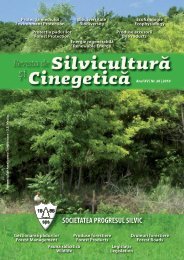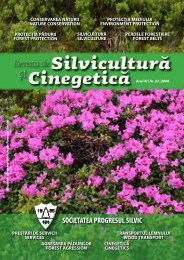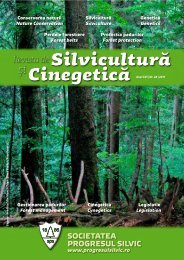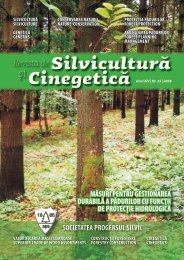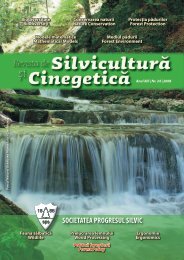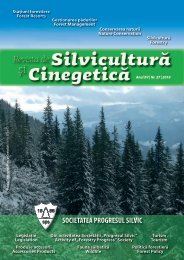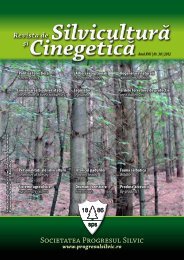Silviculture and Cinegetics Review - Societatea Progresul Silvic
Silviculture and Cinegetics Review - Societatea Progresul Silvic
Silviculture and Cinegetics Review - Societatea Progresul Silvic
You also want an ePaper? Increase the reach of your titles
YUMPU automatically turns print PDFs into web optimized ePapers that Google loves.
FORESTRY BELTS SILVICULTURE AND CINEGETICS REVIEW XVII/30/2012<br />
subsidence do not allow the differentiation in the<br />
stationary complex of multiple stationary units.<br />
8. Polyfunctional species selection<br />
Species used for the afforestation of the ground wave<br />
from the factory Kronospan of Stupini, must meet<br />
properties enabling them the development in special<br />
stationary conditions:<br />
- resistance to dryness (season) of the soil - a<br />
necessary condition because species do not benefit<br />
from the contribution groundwater, slope gradient is<br />
large (45 g), with significant loss of water from<br />
precipitation through surface water runoff <strong>and</strong> runoffs,<br />
<strong>and</strong> on sunny slopes (southern <strong>and</strong> western) <strong>and</strong> the<br />
plateau, under loose soil <strong>and</strong> medium texture, this<br />
quality this becomes a very important requirement;<br />
- adaptation to skeletal soils with low physiological<br />
space - especially on the northern ground wave, where<br />
the amount of skeleton is variable <strong>and</strong> sometimes up<br />
to 25 to 30%;<br />
- to withst<strong>and</strong> an alkaline pH (7.8 to 8.2);<br />
- to be calcicole species, which support high soil<br />
carbon content (calcium: 14,740 ppm);<br />
- To support the content of salts of the soil (Cu: 10.67<br />
ppm <strong>and</strong> 12.44 ppm As);<br />
- Resistant to industrial pollution <strong>and</strong> road with<br />
fluoride (12.44 ppm);<br />
- Rapidly growing in youth to realize as quickly as<br />
possible the functions for which the protection forest<br />
belt was created;<br />
- to easily regenerate naturally, to spread later in the<br />
gaps created by the drying of seedlings after planting<br />
<strong>and</strong> to achieve impenetrable hedges;<br />
- To cover soil well <strong>and</strong> improve it through litter <strong>and</strong><br />
root associations;<br />
- to withst<strong>and</strong> the injuries caused by natural<br />
phenomena: wind (especially on the plateau <strong>and</strong> upper<br />
third), heavy rains (which can erode slopes), frost, ice<br />
etc.;<br />
- to have the opportunity of defense against aggression<br />
caused by domestic or wild animals (spinyspecies,<br />
inedible, which make impenetrable thickets or hedges)<br />
<strong>and</strong> to withst<strong>and</strong> grazing;<br />
- to possess rich <strong>and</strong> powerful rooting respectively the<br />
power to highly sprout <strong>and</strong> sucker, to secure unstable<br />
slopes, with active erosion <strong>and</strong> with a potentially<br />
burial of seedlings by l<strong>and</strong>slides, collapses <strong>and</strong> cracks.<br />
In the tables 3a <strong>and</strong> 3b were centralized woody<br />
species that simultaneously meet the characteristics of<br />
adaptation to pursued pedo-fluid conditions <strong>and</strong><br />
functionality.<br />
9. Afforestation formula <strong>and</strong> scheme<br />
Tree st<strong>and</strong>s of mixed resinous <strong>and</strong> deciduous are those<br />
that provide the best protection <strong>and</strong> soil improvement<br />
<strong>and</strong> the best use of degraded l<strong>and</strong> (Miulescu <strong>and</strong><br />
Tăbăcaru, 1963). In the hill regions, of the sessile oak<br />
area these species are:<br />
- on soils with mild to medium texture: ash, mountain<br />
maple, flowering ash, privet, red dogwood <strong>and</strong> cornel<br />
tree;<br />
- on semiskeletal soils: black pine, flowering ash,<br />
common maple, hawthorn, red dogwood etc.;<br />
- on soils with medium to heavy texture: black pine,<br />
ash, mountain maple, pear, red dogwood, spindle-tree,<br />
privet, Turkestan elm;<br />
- on calcareous soils: black pine, Turkestan elm,<br />
flowering ash, cherry, cherry-plum, privet, cornel tree,<br />
red dogwood;<br />
- on l<strong>and</strong> with fragmented soils: ash, oleaster, privet,<br />
sea buckthorn, red dogwood.<br />
Based on the specific stationary requirements <strong>and</strong> the<br />
compatibility of the species characteristics with these,<br />
the following formula for afforestation was used<br />
(Table 4): 30% Pi.n. 12% Pa.m. Fr. Ul.t. Gl. 31% Sl.<br />
Mj. 27% Pd. Mc. L.c.<br />
Applying this formula differs however in relation to<br />
the forms of relief (slopes of 45 gr. <strong>and</strong> plateau) the<br />
slopes exposure (sunny - SW - or shadow - NE), slope<br />
position (upper or lower third), or the portions of l<strong>and</strong><br />
that runoffs <strong>and</strong> l<strong>and</strong>slides are localized (Table 4a).<br />
The chosen planting scheme (Table 4a) (Option 1) is<br />
10,000 seedlings / ha (1 x 1 m) (otskirts / hedges are<br />
more dense: 1 x 0.5 m).<br />
On the plateau of the ground waves are planted:<br />
- Rows of edge, pure, of oleaster, with role of fixing<br />
securely the slope rim, where there are cracking <strong>and</strong><br />
l<strong>and</strong>slides phenomena.<br />
- 3 internal rows with black pine mixed with<br />
flowering ash (ailanthus <strong>and</strong> resistant shrub species.<br />
On the sunny slopes:<br />
- Mixture of black pine <strong>and</strong> xerophytes species -<br />
flowering ash (ailanthus) cherry-plum, Turkestan elm,<br />
resistant shrubs);<br />
- For the slope stability were introduced two pure<br />
lines of oleaster (at regular intervals compared to the<br />
edge <strong>and</strong> the basis of the slope);<br />
- At the edge, it was designed a hedge of honey locust.<br />
On the shadowed slopes:<br />
- Mixture of black pine <strong>and</strong> mesophilic species -<br />
maple, ash <strong>and</strong> mesophilic shrubs - at the bottom of of<br />
the slope;<br />
95



